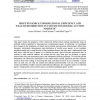Free Online Productivity Tools
i2Speak
i2Symbol
i2OCR
iTex2Img
iWeb2Print
iWeb2Shot
i2Type
iPdf2Split
iPdf2Merge
i2Bopomofo
i2Arabic
i2Style
i2Image
i2PDF
iLatex2Rtf
Sci2ools
CI
2007
2007
Price Dynamics, Informational Efficiency, and Wealth Distribution in Continuous Double-Auction Markets
This paper studies the properties of the continuous double auction trading mechanishm using an artificial market populated by heterogeneous computational agents. In particular, we investigate how changes in the population of traders and in market microstructure characteristics affect price dynamics, information dissemination and distribution of wealth across agents. In our computer simulated market only a small fraction of the population observe the risky asset’s fundamental value with noise, while the rest of agents try to forecast the asset’s price from past transaction data. In contrast to other artificial markets, we assume that the risky asset pays no dividend, so agents cannot learn from past transaction prices and subsequent dividend payments. We find that private information can effectively disseminate in the market unless market regulation prevents informed investors from short selling or borrowing the asset, and these investors do not constitute a critical mass. In such ...
Artificial Markets | CI 2007 | CI 2008 | Markets | Risky Asset |
| Added | 18 Dec 2010 |
| Updated | 18 Dec 2010 |
| Type | Journal |
| Year | 2007 |
| Where | CI |
| Authors | Javier Gil-Bazo, David Moreno, Mikel Tapia |
Comments (0)

